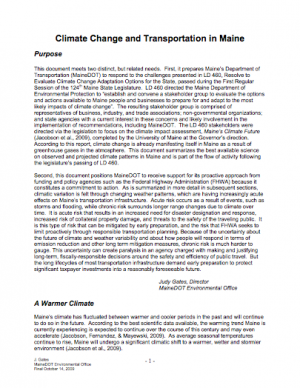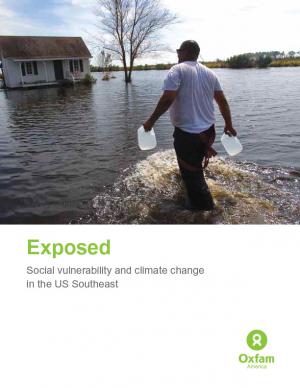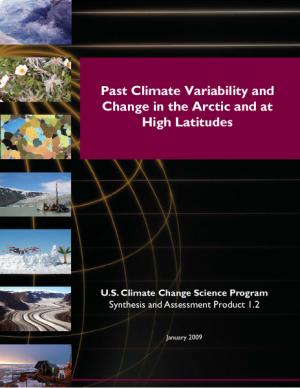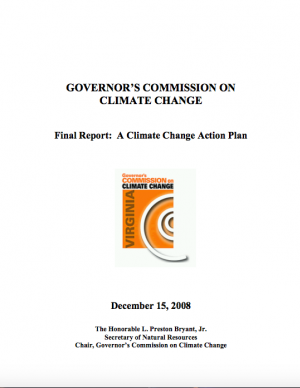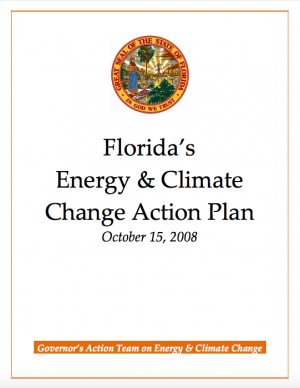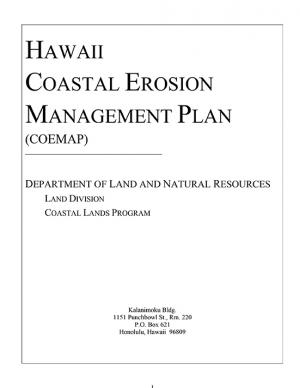Access a range of climate-related reports issued by government agencies and scientific organizations. Browse the reports listed below, or filter by scope, content, or focus in the boxes above. To expand your results, click the Clear Filters link.
This document sets forth a plan, required by Hawai'i's 2007 Session Laws, to achieve the maximum practically and technically feasible reductions in greenhouse gas emissions to or below 1990 levels of emissions by 2020.
This strategy provides initial guidance on actions Virginia’s conservation community can implement immediately to enhance the conservation of wildlife and habitats in the face of climate change, even as more comprehensive adaptation strategies are developed. Conservation strategies include specific actions for conserving species and habitats, developing new data and climate modeling resources, and implementing new outreach efforts related to climate change.
This document meets two distinct, but related, needs. First, it prepares Maine’s Department of Transportation (MaineDOT) to respond to the challenges presented in Maine's LD 460, Resolve to Evaluate Climate Change Adaptation Options for the State. Second, this document positions MaineDOT to receive support for its proactive approach from funding and policy agencies such as the Federal Highway Administration because it constitutes a commitment to action.
The Michigan Climate Action Council (MCAC) was created on November 14, 2007, by Governor Jennifer Granholm. Governor Granholm charged the MCAC with producing a greenhouse gas emissions inventory and forecast, developing this comprehensive Climate Action Plan with recommended greenhouse gas reduction goals and potential actions to mitigate climate change in various sectors of the economy, and advising state and local governments on measures to address climate change.
This Climate Action Plan was developed for New Hampshire by the Climate Change Policy Task Force, initiated by Governor John Lynch in 2008. The plan aims to achieve the greatest feasible reductions in greenhouse gas emissions while also providing the greatest possible long-term economic benefits to New Hampshire.
Historically, studies about climate hazards and social vulnerability have been conducted in separate silos. The Social Vulnerability Index (SoVI) is the first study of its kind to examine both the potential impact of natural hazards and which populations are most likely to be negatively affected. This research, commissioned by Oxfam America, includes a series of layered maps that depict social and climate change-related hazard vulnerability. The maps assist in identifying hotspots in the U.S. Southeast, which are at significant risk in the face of four particular climate change-related hazards: drought, flooding, hurricane force winds, and sea level rise. The specific region of focus is the 13-state region of the US Southeast: Alabama, Arkansas, Florida, Georgia, Kentucky, Louisiana, Maryland, Mississippi, North Carolina, South Carolina, Tennessee, Texas, and Virginia. Roughly 80 percent of all U.S. counties that experience persistent poverty (defined as a county in which at least 20 percent of the population experiences poverty for three decades or more) lie in this region.
A collection of case studies and information about how coastal communities can plan for and adapt to climate change. These resources represent a national guide for how coastal communities can plan and adapt. Case study issues range from coastal managers addressing sea level rise in Rhode Island to coral bleaching caused by rising sea temperatures in Florida.
This report is designed to help Oregon's local decision makers prepare adaptation plans and state agencies to coordinate their infrastructure plans with local adaptation initiatives.
Average temperatures in the Arctic have increased at almost twice the rate of the planet as a whole. Such temperature changes have been accompanied by shrinking sea ice, melting ice and permafrost on land, and widespread impacts to land and ocean ecosystems. This Synthesis and Assessment Product, developed as part of the U.S. Climate Change Science Program, offers recommendations for future research in this area.
The Action Plan describes climate effects on the built environment, natural systems, and human health in Virginia and sets forth a comprehensive set of recommendations for reducing greenhouse gases.
In 2008, the Iowa General Assembly created the Iowa Climate Change Advisory Council (ICCAC), consisting of 23 voting members appointed by the state's governor. The ICCAC was tasked with developing a greenhouse gas emission reduction proposal to the governor and the general assembly. This document is the council's final report.
This plan contains 50 separate policy recommendations to reduce harmful greenhouse gas emissions. The report estimates that if all its recommendations were implemented, the state would meet its emissions reduction targets, enjoy increased energy security, and see a net cost savings of more than $28 billion from 2009 to 2025.
Governor Mike Beebe established the Governor’s Commission on Global Warming, representing a wide diversity of views with members from business, industry, environmental groups, and academia. The commission was charged with moving Arkansas in the right direction to start stabilizing global climate, allow Arkansas to lead the nation in attracting clean and renewable energy industries, and to reduce consumer energy dependence on current carbon-generating technologies and expenditures. This document is the commission's final report.
In 2002, North Carolina's Governor Hunt signed the Clean Smokestack Act, which tasked the North Carolina Department of Environment and Natural Resources’ Division of Air Quality with studying options for reducing carbon dioxide emissions from coal-burning power plans and other sources. This report provides the Division's recommended mitigation options for reducing North Carolina’s carbon emissions.
This report offers recommendations to protect Maryland’s future economic well-being, environmental heritage, and public safety from the impacts of sea level rise.
The Global Warming Task Force was created by Wisconsin Governor Jim Doyle in April 2007. The Task Force created this report, which contains its policy recommendations to reduce greenhouse gas emissions in Wisconsin, as well as its short- and long-term goals for reducing greenhouse gas emissions in the state.
In February of 2007, Governor Sanford of South Carolina established the Governor’s Climate, Energy, and Commerce Committee to develop a Climate, Energy, and Commerce Action Plan containing specific recommended actions for mitigating greenhouse gas emissions. This document is the committee's action plan, which documents its recommendations and associated analyses to reduce greenhouse gas emissions and enhance energy and economic policy in South Carolina by 2020 and beyond.
Ted Kulongoski, Governor of Oregon from 2003–2011, selected the Climate Change Integration Group (CCIG) to develop a framework for making informed decisions to minimize the more extreme impacts of climate change. Kulongoski wanted the CCIG to create a strategy for Oregon to apply the measures from the 2004 Oregon Strategy for Greenhouse Gas Reductions. In this report, the CCIG proposes that Oregon takes steps toward developing a framework that will assist individuals, businesses, and governments to incorporate climate change into their planning processes.
Vermont's Governor James Douglas established the Governor’s Commission on Climate Change by executive order on December 5, 2005. The state's goal, as outlined in this document, is to reduce its greenhouse gas emissions by 25 percent from 1990 levels by 2012, 50 percent by 2028, and 75 percent by 2050.
In 2007, Nevada's Governor Jim Gibbons signed an executive order that created the Nevada Climate Change Advisory Committee. The order directed the committee to propose recommendations to further reduce greenhouse gas emissions in Nevada, and tasked it with writing this three-part report highlighting the potential impacts, accomplishments, and recommendations to address the issue of climate change in Nevada.
In 2006, Minnesota Governor Tim Pawlenty announced the “Next Generation Energy Initiative,” which included the “development of a comprehensive plan to reduce Minnesota’s emissions of greenhouse gases.” During this announcement, the governor requested that the Center for Climate Strategies help in the development of Minnesota's Climate Mitigation Action Plan and the formation of the Minnesota Climate Change Advisory Group. The Climate Change Advisory Group, which was tasked with developing a comprehensive set of state-level policy recommendations to the governor, produced this report.
The Montana Climate Change Advisory Committee, established by the state's Department of Environmental Quality, evaluated greenhouse gas reduction opportunities in various places in Montana’s economy. The committee agreed upon the 54 policy recommendations described in this Climate Change Action Plan, designed to help reduce Montana’s emissions of heat-trapping greenhouse gases to 1990 levels by the year 2020.
This report summarizes scientific understandings of climate change and its potential impact on Utah and the western United States, created by a "blue ribbon" advisory council appointed by Utah Governor Huntsman. The report makes around 70 recommendations for fighting global warming, including developing significant amounts of renewable energy with incentives and tax credits, encouraging the capture and disposal of carbon dioxide, improving efficiency at power plants, implementing an aggressive mass transit strategy, and preserving open space and agricultural land and protecting forests. The report, however, does not include specific policy recommendations or rules to implement action.
In 2006, Illinois Governor Blagojevich launched the state's Global Warming Initiative by executive order that created the Illinois Climate Change Advisory Group. The group's purpose was to recommend state-level strategies to meet Illinois’ greenhouse gas reduction goals, which are similar to those set by other states and those proposed in Congress: 1990 levels by 2000, and 60 percent below 1990 levels by 2050. This document is the Advisory Group's report submitted to the governor.
This report summarizes findings from a review of coastal hazards associated with sea level rise, hurricanes, nor'easters, and reduced sediment supply. The study also evaluates existing policies and potential knowledge gaps, and develops potential adaptation policies.
In June 2005, Governor Bill Richardson signed an executive order establishing the New Mexico Climate Change Advisory Group, and directed the group to prepare this report. It includes a projection of the state’s future greenhouse gas emissions and recommendations for policy changes to aid in the reduction of New Mexico’s total greenhouse gas emissions to 2000 levels by 2012, 10 percent below 2000 by 2020, and 75 percent by 2050.
Enacted in 2003, Maine's Public Law 237 required the state's Department of Environmental Protection to develop and submit this Climate Action Plan. The CAP includes plans to reduce greenhouse gas emissions to 1990 levels by 2010 and to 10 percent below 1990 levels in 2020.
This document identifies goals and actions to conserve and restore Oregon’s species, habitats, and ecosystems. The report addresses climate change as a key conservation issue, and many of the recommendations provided consider adaptation measures to address species and habitat conservation needs. The 10-year revision of the Strategy and its Nearshore Component is currently under review by the U.S. Fish and Wildlife Service and will be posted at the provided URL once approved.
In 1991, the Missouri Commission on Global Climate Change and Ozone Depletion concluded that climate change is being bolstered by human activity. This report includes the 1991 final report of that commission, the 1992 Final Report of the Statewide Energy Study, the 1992 final report of the Department of Natural Resources’ Institute Project, and two previous reports from the U.S. Environmental Protection Agency Phase 1 and Phase 2 Greenhouse Gas projects, which were issued in 1996 and 1990, respectively.
The Rhode Island Department of Environmental Management and the State Energy Office grouped together over 30 individuals to develop a Greenhouse Gas Action Plan for Rhode Island. This group was created because of growing concerns of the impact carbon dioxide and other greenhouse gases will have on the planet. They created this climate action plan with their recommendations for reducing greenhouse gas emissions.
This document, known as the COEMAP, provides a framework for community discussion and assessment of coastal erosion and beach loss in Hawai'i. The objective of COEMAP, and the public dialogue it seeks to foster, is to outline socioeconomic and technical mechanisms for conserving and restoring Hawai'i’s beaches in a framework of mitigating erosion impacts and reducing exposure to coastal hazards for future generations.


